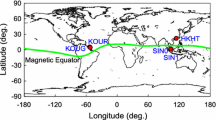Abstract
The introduction of the unencrypted global positioning system (GPS) L2 civil (L2C) signal has the potential to improve measurements made with the L2 frequency, an important observable in GPS-based ionospheric research and monitoring. Recent work has shown significant differences between the legacy L2P(Y) and L2C-derived total electron content rate of change index (ROTI). This difference is observed between L2P(Y) and L2C-derived ROTI with certain receiver models and between zero-baseline receiver pairs. We discuss the likely cause for these differences: L1-aided tracking used to track both the L2P(Y) and L2C signals. We also present L2C data that are confirmed to be from tracking independent of L1. Using the ionospheric-free linear combination, we show that the independently tracked carrier phase dynamics are significantly more accurate than the L1-aided observables. This result is confirmed by comparing the behavior of the L2C and L2P(Y) carrier phase observables upon a sudden antenna rotation.




Similar content being viewed by others
References
Al-Fanek O, Skone S, Lachapelle G, Fenton P (2007) Evaluation of L2C observations and limitations. In: Proceedings of ION GNSS 2007, Institute of Navigation, Fort Worth, Texas, USA, 25–28 Sept, pp 2510–2518
Bhattacharyya A, Beach TL, Basu S, Kintner PM (2000) Nighttime equatorial ionosphere: GPS scintillations and differential carrier phase fluctuations. Radio Sci 35(1):209–224. https://doi.org/10.1029/1999rs002213
Carrano CS, Groves KM, McNeil JW, Doherty PH (2013) Direct measurement of the residual in the ionosphere-free linear combination during scintillation. In: Proceedings of ION ITM 2013, Institute of Navigation, San Diego, California, USA, 28–30 Jan, pp 585–596
Datta-Barua S, Walter T, Blanch J, Enge P (2008) Bounding higher-order ionosphere errors for the dual-frequency GPS user. Radio Sci. https://doi.org/10.1029/2007rs003772
Jayachandran PT, Langley RB, MacDougall JW, Mushini SC, Pokhotelov D, Hamza AM, Mann IR, Milling DK, Kale ZC, Chadwick R, Kelly T (2009) Canadian high arctic ionospheric network (CHAIN). Radio Sci. https://doi.org/10.1029/2008rs004046
Kim D, Serrano L, Langley R (2006) Phase wind-up analysis: assessing real—time kinematic performance. GPS World 17(9):58–64
Komjathy A (1997) Global ionospheric total electron content mapping using the global positioning system. Ph.D. dissertation, Department of Geodesy and Geomatics Engineering, Technical report no. 188, University of New Brunswick, Fredericton, Canada
Krankowski A, Cherniak I, Zakharenkova I (2017) The new IGS ionospheric product—TEC fluctuation maps and their scientific application. Abstracts of EGU General Assembly, Vienna, 23–28 Apr, p 8109
Lim D, Moon S, Park C, Lee S (2006) L1/L2CS GPS receiver implementation with fast acquisition scheme. In: IEEE/ION plans 2006, Institute of Navigation, Coronado, California, USA, 25–27 Apr. https://doi.org/10.1109/plans.2006.1650683
Liu Z, Yang Z, Chen W (2017) A study on ionospheric irregularities and associated scintillations using multi-constellation GNSS observations. In: Proceedings of ION PNT, Institute of Navigation, Honolulu, Hawaii, USA, 1–4 May 2017
Mitchell CN, Alfonsi L, Franceschi GD, Lester M, Romano V, Wernik AW (2005) GPS TEC and scintillation measurements from the polar ionosphere during the October 2003 storm. Geophys Res Lett. https://doi.org/10.1029/2004gl021644
Montenbruck O, Steigenberger P, Prange L, Deng Z, Zhao Q, Perosanz F, Romero I, Noll C, Sturze A, Weber G, Schmid R (2017) The multi-GNSS experiment (MGEX) of the international GNSS service (IGS)—achievements, prospects and challenges. Adv Space Res 59(7):1671–1697. https://doi.org/10.1016/j.asr.2017.01.011
Pi X, Mannucci AJ, Lindqwister UJ, Ho CM (1997) Monitoring of global ionospheric irregularities using the worldwide GPS network. Geophys Res Lett 24(18):2283–2286. https://doi.org/10.1029/97gl02273
Prikryl P, Jayachandran PT, Mushini SC, Chadwick R (2011) Climatology of GPS phase scintillation and HF radar backscatter for the high-latitude ionosphere under solar minimum conditions. Ann Geophys 29(2):377–392. https://doi.org/10.5194/angeo-29-377-2011
Van Dierendonck AJ, Klobuchar J, Hua Q (1993) Ionospheric scintillation monitoring using commercial single frequency C/A code receivers. In: Proceedings of ION GPS 1993, Salt Lake City, Utah, pp 1333–1342
Woo KT (2000) Optimum semicodeless carrier phase tracking of L2. Navigation 47(2):82–99. https://doi.org/10.1002/j.2161-4296.2000.tb00204.x
Yang Z, Liu Z (2016) Investigating the inconsistency of ionospheric ROTI indices derived from GPS modernized L2C and legacy L2 P(Y) signals at low-latitude regions. GPS Solut 21(2):783–796. https://doi.org/10.1007/s10291-016-0568-3
Acknowledgements
CHAIN infrastructure funding was provided by the Canadian Foundation for Innovation and the New Brunswick Innovation Foundation. CHAIN operation is conducted in collaboration with the Canadian Space Agency. The data used can be obtained by contacting CHAIN directly. We thank the J. R. Armstrong Family Foundation for funding the presented research. Jayachandran and Langley are also supported by the Natural Sciences and Engineering Research Council of Canada.
Author information
Authors and Affiliations
Corresponding author
Rights and permissions
About this article
Cite this article
McCaffrey, A.M., Jayachandran, P.T., Langley, R.B. et al. On the accuracy of the GPS L2 observable for ionospheric monitoring. GPS Solut 22, 23 (2018). https://doi.org/10.1007/s10291-017-0688-4
Received:
Accepted:
Published:
DOI: https://doi.org/10.1007/s10291-017-0688-4




